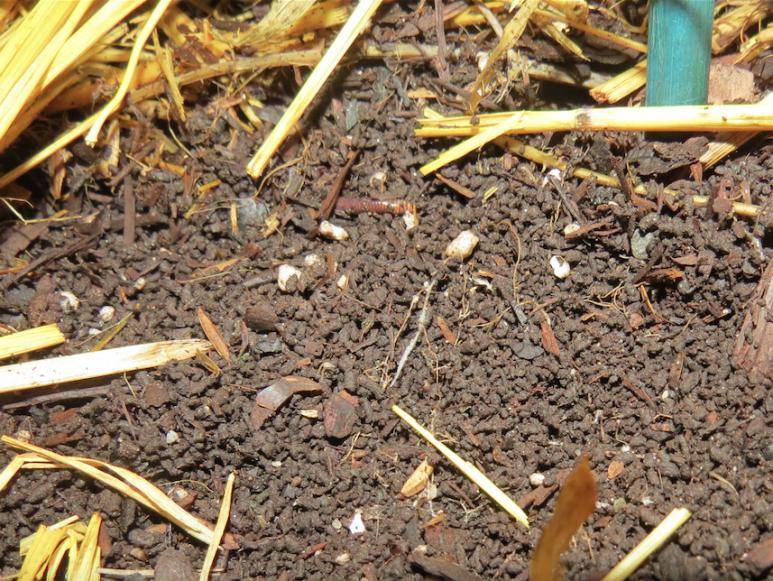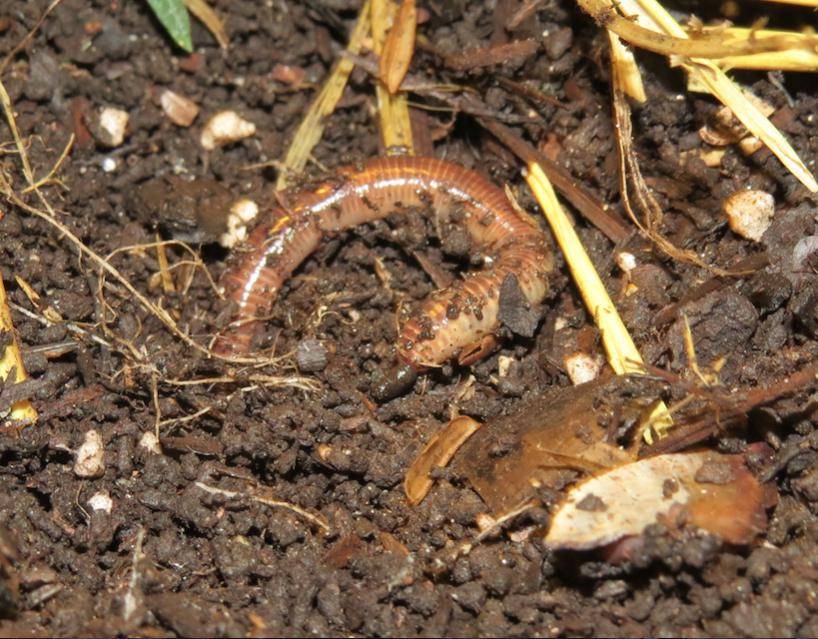Day 1 of Flowering
Day 1 of Flowering

I like to pull out all of the plants in the middle of the room to make a big square when I foliar spray, that way I can really get in and around each plant to ensure full coverage. Today I sprayed the recipe listed on the previous page, and will spray one more time on Day 7 before letting the girls be for the next 2 months.

Lights out!

Another added benefit of adding Red Wigglers and/or European Nightcrawlers to your container is a continuous supply of fresh earthworm castings to the top layer

After peeling back the straw layer, I witnessed one of the work horses pinching a hefty loaf... now that's fresh!
"Vermicomposts are products derived from the accelerated biological degradation of organic wastes by earthworms and microorganisms. Earthworms consume and fragment the organic wastes into finer particles by passing them through a grinding gizzard and derive their nourishment from microorganisms that grow upon them. The process accelerates the rates of decomposition of the organic matter, alter the physical and chemical properties of the material, leading to a humification effect in which the unstable organic matter is fully oxidized and stabilized (Albanell et al., 1988; Orozco et al., 1996).
The end product, commonly referred to as vermicompost is greatly humified through the fragmentation of the parent organic materials by earthworm sand colonization by microorganisms (Edwards and Neuhauser; Edwards, 1998). Vermicomposts are finely divided peat-like materials with high porosity, aeration, drainage, water-holding capacity (Edwards and Burrows, 1988). They have greatly increased surface areas, providing more microsites for microbial decomposing organisms, and strong adsorption and retention of nutrients (Shi-wei and Fu-zhen, 1991). Albanell et al. (1988) reported that vermicomposts tended to have pH values near neutrality which may be due to the production of CO2 and organic acids produced during microbial metabolism. They also reported that their moisture content was reduced progressively during vermicomposting giving final moisture contents between 45% and 60%, the ideal moisture contents for land-applied composts (Edwards 1983)."
Day 1 of Flowering
I like to pull out all of the plants in the middle of the room to make a big square when I foliar spray, that way I can really get in and around each plant to ensure full coverage. Today I sprayed the recipe listed on the previous page, and will spray one more time on Day 7 before letting the girls be for the next 2 months.
Lights out!
Another added benefit of adding Red Wigglers and/or European Nightcrawlers to your container is a continuous supply of fresh earthworm castings to the top layer
After peeling back the straw layer, I witnessed one of the work horses pinching a hefty loaf... now that's fresh!
"Vermicomposts are products derived from the accelerated biological degradation of organic wastes by earthworms and microorganisms. Earthworms consume and fragment the organic wastes into finer particles by passing them through a grinding gizzard and derive their nourishment from microorganisms that grow upon them. The process accelerates the rates of decomposition of the organic matter, alter the physical and chemical properties of the material, leading to a humification effect in which the unstable organic matter is fully oxidized and stabilized (Albanell et al., 1988; Orozco et al., 1996).
The end product, commonly referred to as vermicompost is greatly humified through the fragmentation of the parent organic materials by earthworm sand colonization by microorganisms (Edwards and Neuhauser; Edwards, 1998). Vermicomposts are finely divided peat-like materials with high porosity, aeration, drainage, water-holding capacity (Edwards and Burrows, 1988). They have greatly increased surface areas, providing more microsites for microbial decomposing organisms, and strong adsorption and retention of nutrients (Shi-wei and Fu-zhen, 1991). Albanell et al. (1988) reported that vermicomposts tended to have pH values near neutrality which may be due to the production of CO2 and organic acids produced during microbial metabolism. They also reported that their moisture content was reduced progressively during vermicomposting giving final moisture contents between 45% and 60%, the ideal moisture contents for land-applied composts (Edwards 1983)."










